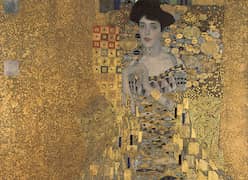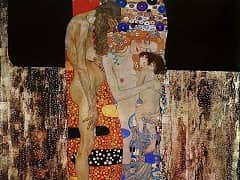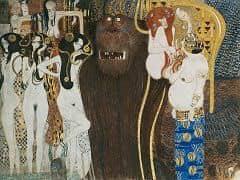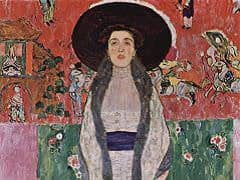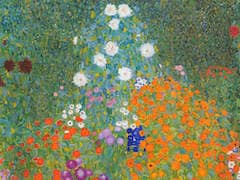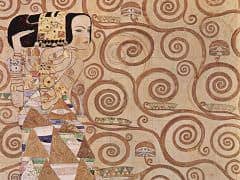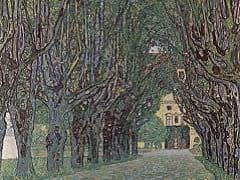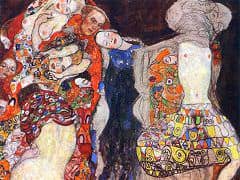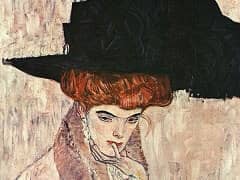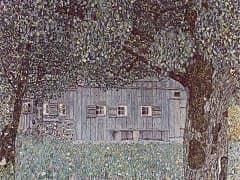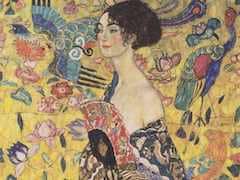Gustav Klimt Biography
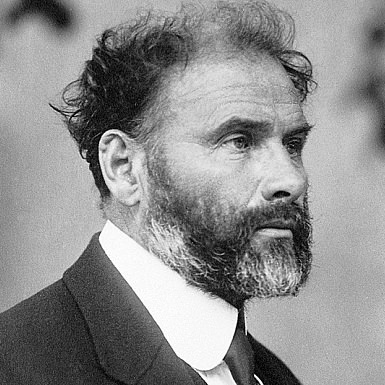
Gustav Klimt was born in Vienna, in 1862, into a lower middle-class family of Moravian origin. His father, Ernst Klimt, worked as an engraver and goldsmith, earning very little, and the artist's childhood was spent in relative poverty. The painter would have to support his family financially throughout his life.
In 1876, Gustav Klimt was awarded a scholarship to the Vienna School of Arts and Crafts (Kunstgewerbeschule), where he studied until 1883, and received training as an architectural painter. He revered the foremost history painter of the time, Hans Makart. Klimt readily accepted the principles of a conservative training; his early work may be classified as academic. In 1877 his brother Ernst, who, like his father, would become an engraver, also enrolled in the school. The two brothers and their friend Franz Matsch began working together; by 1880 they had received numerous commissions as a team they called the "Company of Artists", and helped their teacher in painting murals in the Kunsthistorisches Museum in Vienna.
After finishing his studies, Gustav Klimt opened a studio together with Matsch and Ernst Klimt. The trio specialized in interior decoration, particularly theaters. Already by the 1880s, they were renowned for their skill and decorated theaters throughout the Austro-Hungarian Empire, and much of their work can still be seen there. In 1885, they were commissioned to decorate the Empress Elizabeth's country retreat, the Villa Hermes near Vienna (Midsummer Night's Dream). In 1886, the painters were asked to decorate the Viennese Burgtheater, effectively recognizing them as the foremost of decorators of Austria. Works that Klimt painted for this project include the Cart of Thespis, the Altars of Dionysosand Apollo and the Theater at Taormina, as well as scenes from the Globe Theater of William Shakespeare.
At the completion of the work in 1888, the painters were awarded the Golden Service Cross (Verdienstkreuz), and Klimt was commissioned to paint the Auditorium of the Old Burgtheater, the work that would bring him to the height of his fame. This painting, with its almost photographic accuracy is considered one of the greatest achievements in Naturalist painting. As a result, Klimt was awarded the Emperor's Prize and became a fashionable portraitist, as well as the leading artist of his day. Paradoxically, it was at this point, with a fabulous career as a classicist painter unfolding before him, that Klimt began turning towards the radical new styles of the Art Noveau.
In the coming few years, the artistic trio fell apart. Franz Matsch wanted to branch out into portrait painting, which he did with some success. Meanwhile, Gustav Klimt's changing style made it impossible for them to work together on any project. Furthermore, Ernst Klimt died in 1892, shortly after the death of their father.
Struck by this double tragedy, Gustav retreated from public life, focusing on experimentation and the study of contemporary styles of art, as well as historical styles that were overlooked within the establishment, such as Japanese, Chinese, Ancient Egyptian and Mycenaean art. In 1893, he began work on his last public commission: the paintings Philosophy, Medicine and Jurisprudence, for the University of Vienna. The three would only be completed in the early 1900s, and they would be criticized severely for their radical style and what was, according to the mores of the time, lewdness. Unfortunately, the paintings were destroyed during the Second World War and only black-and-white reproductions of them remain.
All art is erotic. " - Gustav Klimt
The painter was not alone in his opposition to the Austrian artistic establishment of the time. In 1897, he, together with forty other notable Viennese artists, resigned from the Academy of Arts and founded the "Union of Austrian Painters", more commonly known as the Secession. Klimt was immediately elected president. While the Union had no clearly defined goals or support for particular styles, it was against the classicist establishment, which is found to be oppressive.
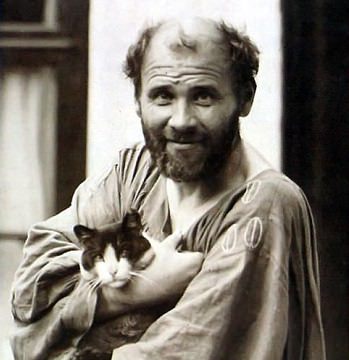
The Viennese culture of the beginning of the century that witnessed the fall of the Austro-Hungary empire, gave birth at the same time to the thinking of Sigmund Freud
and Ludwig Wittgenstein - in the psychoanalysis and the philosophy, to the music of Arnold Schoenberg. In 1902, Gustav Klimt finished the Beethoven Frieze for the 14th Vienna Secessionist
exhibition, which was intended to be a celebration of the composer and featured a monumental, polychromed sculpture by Max Klinger. Meant for the exhibition only, the frieze was painted directly on the walls with light materials.
After the exhibition the painting was preserved, although it did not go on display until 1986.
During this period Klimt did not confine himself to public commissions. Beginning in the late 1890s he took annual summer holidays with the Flöge family on the shores of Attersee and painted many
of his landscapes there. Klimt was largely interested in painting figures; these works constitute the only genre aside from figure-painting which seriously interested Klimt. Klimt's Attersee
paintings are of a number and quality so as to merit a separate appreciation. Formally, the landscapes are characterized by the same refinement of design and emphatic patterning as the figural
pieces. Deep space in the Attersee works is so efficiently flattened to a single plane, it is believed that Klimt painted them while looking through a telescope.
Klimt's 'Golden Phase' was marked by positive critical reaction and success. Many of his paintings from this period used gold leaf; the prominent use of gold can first be traced back to Pallas Athene,
(1898) and Judith and the Head of Holofernes (1901), although the works most popularly associated with this period are the Portrait of Adele Bloch-Bauer I (1907)
and The Kiss (1907-1908). Klimt travelled little but trips to Venice and Ravenna, both famous for their beautiful mosaics, most likely inspired his gold technique and his
Byzantine imagery. In 1904, he collaborated with other artists on the lavish Palais Stoclet, the home of a wealthy Belgian industrialist, which was one of the grandest monuments of the Art Nouveau age. Klimt's
contributions to the dining room, including both Fulfillment and Expectation, were some of his finest decorative work, and as he publicly stated,
"probably the ultimate stage of my development of ornament." Between 1907 and 1909, Klimt painted five canvases of society women wrapped in fur. His apparent love of costume is expressed in the many photographs of Floge
modeling clothing he designed.
As he worked and relaxed in his home, Gustav Klimt normally wore sandals and a long robe with no undergarments. His simple life was somewhat cloistered, devoted to his art and family and little else except the Secessionist Movement, and he avoided cafe society and other artists socially. Klimt's fame usually brought patrons to his door, and he could afford to be highly selective. His painting method was very deliberate and painstaking at times and he required lengthy sittings by his subjects. Though very active sexually, he kept his affairs discreet and he avoided personal scandal.
By 1910, Gustav Klimt had moved past his Golden Style. One of his last pictures in that style was Death and Life (1908-1910). In 1911, the painting was shown at the International
Exhibition in Rome, where it won first place. However, the artist was dissatisfied with the work, and in 1912, he changed the background from gold to blue.
Gustav Klimt lived with his mother Anna Klimt for his whole life. In 1915 his mother Anna died. Gustav Klimt died three years later in Vienna on February 6, 1918, having suffered a stroke and pneumonia. He was buried at the Hietzing Cemetery in Vienna.
Numerous paintings were left unfinished.
Gustav Klimt's paintings have brought some of the highest prices recorded for individual works of art. In 2006, the 1907 Portrait of Adele Bloch-Bauer I, was purchased for the Neue Galerie in
New York by Ronald Lauder for a reported US $135 million, sets the record as the highest reported price ever paid for a painting.
Truth is like fire; to tell the truth means to glow and burn. " - Gustav Klimt
Gustav Klimt's work is often distinguished by elegant gold or coloured decoration, spirals and swirls, and phallic shapes used to conceal the more erotic positions of the drawings upon which many of his paintings
are based. This can be seen in Judith and the Head of Holofernes (1901), and in The Kiss (1907-1908), and especially in Danae (1907). One of the most common
themes Gustav Klimt used was that of the dominant woman, the femme fatale.
Art historians note an eclectic range of influences contributing to Klimt's distinct style, including Egyptian, Minoan, Classical Greek, and Byzantine inspirations. Gustav Klimt was also inspired by the engravings
of Albrecht Durer, late medieval European painting, and Japanese Rimpa school. His mature works are characterized by a rejection of earlier naturalistic styles, and make use of symbols or symbolic elements
to convey psychological ideas and emphasize the "freedom" of art from traditional culture.



